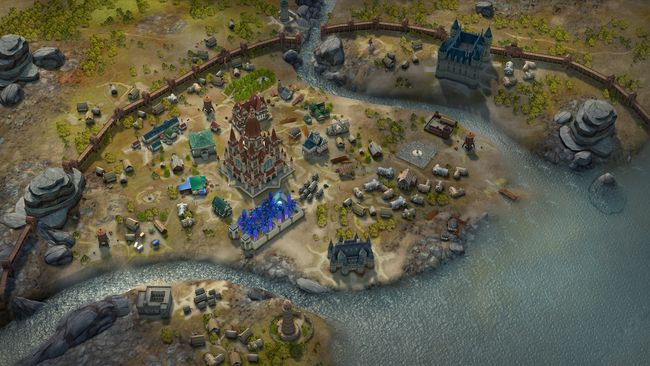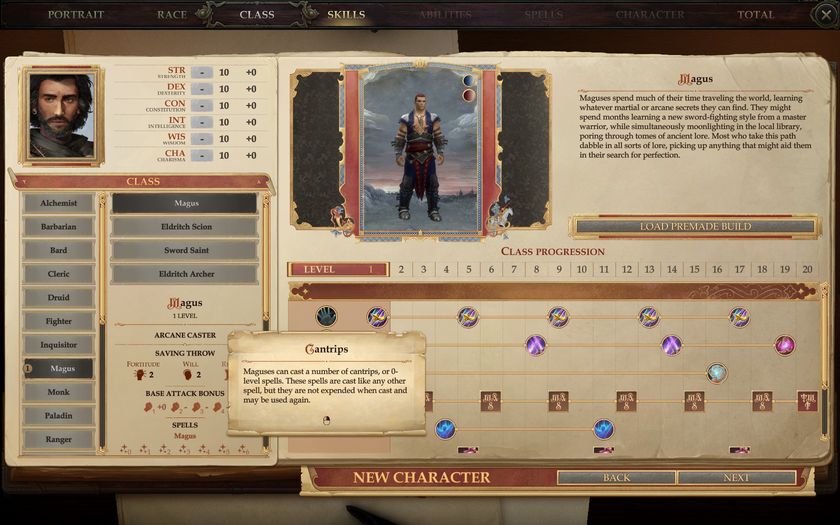Table of Contents Show
This is a simple little guide for people new to pathfinder. From swarms to spellcasters. Im not entirely sure of every single detail thats been changed between classic and this, so take things with a grain of salt.
Adventure Awaits
First off There is no shame in playing the game on normal, easy or anything else play the game at a difficulty level that feels right and dont be afraid to tune it down if its too hard. A real gm would tailor the game to his players, but since you dont have a real gm, dont be afraid to lower the difficulty or raise it as you see fit.
Character Creation
Theres a nice bunch of pregens to choose from, but if you’re anything like me, you want to make your own. Im going to cover the basics of character creation so you can make a fun, useful build.
Race try and get an idea for what class you want to play before you select race. for example a halfling barbarian will have a hard time keeping up with say a human barbarian. that doesnt mean you cant or shouldnt play a halfling barbarian or a dwarf bard, it just means be aware of what each race does.
Ability Scores
- Strength – How easy it is to hit and how much damage you deal with melee. carrying capacity.
- Dex – How easy it is to hit with ranged weapons and adds a dodge bonus to AC. Reflex saves.
- Con – How many hitpoints you have and how far negitive you can go before you die. Fortitude saves. Dont make it below 10 or you will regret it.
- Int – Wiziard and Magus spells. Give aditional skill points (not tested in the game).
- Wis – Cleric and druid spells. Will saves. I recomend not dumping this one.
- Cha – Bard and Sorcerer spells.
If there’s a green tick next to a skill, that means it is important for your class.
When selecting a class, there will be a level progression chart at the bottom. Pathfinder allows multiclassing. Prestiege classes can only be unlocked once the requirements (listed when hovered over) are met. Generally you want to decide if you want a presteige class early on and build yourself around it if so.
- This is your base ability scores.
- Class and Level.
- Melee attacks. you’ll notice four icons. thats because each time your BAB (12.) reaches five, you gain an additional attack. curently I’m getting one attack at -1 to hit. (I’ll explain why when I get to feats).
- Ranged attacks. same as melee, except for anything that specifies itself as a ranged attack (Scorching ray, acid splash, bows, etc).
- Combat manuver Defense and Bonus (look in advanced combat).
- Initiative (See basic combat).
- AC, Flat footed AC, and Touch AC (Basic combat).
- Saving throws. when forced to make a saving throw, you will roll a d20 plus or minus whichever save it is.
- Abilities. Make sure to hover over them to find out more.
- Skills. hover over them to see what each skill is used for.
- spells. the number next to the sparkles shows the level of the spell, the number under shows how many you get per day.
- Base attack bonus. added to all attack rolls.
- what weapons your character is able to use. simple are things like daggers and clubs, martial is things like swords and greataxes, and exotic are special ones such as elven curve blade and andori dueling sword.
- DR is how much damage you ignore per attack. more on this in Tactics.
- Energy resistence. include resistence to the elements and immunities.
Adventurer’s Checklist
Before you can get to hacking and slashing, you have to bring the right supplies.
First and most importantly, BRING A HEALER or some form or healing if none is available. I cannot stress enough how crucial healing is. there are plenty of potions in the intro area for you to bring until you can get a dedicated healer, so make sure to loot all the potions you can.
- Rations, you will be unable to hunt in dungeons and underground. I like to bring double my party number, but you do you.
- AoE(Area of effect) weapons. these include but are not limited to: alchemists fire, acid, burning hands, Alchemists bombs, etc. some monsters can only be hurt by these attacks.
- Debuff removal. Spells like remove curse, remove blindness, and restoration. we’ll get more on this later.
Art of Combat – Basic Combat
Pen and paper pathfinder (try saying that three times fast) features turn based combat. since this game is live action some things are different. one “round” is six second. during a round a character gets one action, a move, and a swift action. Free actions are, as the name suggests, free and can be done limitlessly. We’re going to start with simple and cover spells later.
Initiative Each character rolls iniative as soon as both parties (yours and the opponants) see each other. The higher the Initiative, the faster your character gets to act.
Attack Roll When you make an attack roll, you roll a d20 plus attack bonus. (Other modifiers may also apply to this roll.) If your result equals or beats the target’s Armor Class, you hit and deal damage.
Crits and Crit Fails on a natural one (hence forth known as a nat one) your character auto misses reguardless of bonuses. one a nat 20 they auto hit and “threaten” a critical. after a person rolls a nat 20 they roll again, if they beat the targets ac the second roll they confirm the crit. on a fail they just hit as normal.
Attack Bonus this is added to your d20 roll after it is made. the game calculates bonuses automatically. however, keep in mind that this bonus comes from this formula “Base attack bonus + Strength modifier + size modifier” for a melee weapon (dont worry rogues, there’s a feat to make that dex instead of strength) and “Base attack bonus + Dexterity modifier + size modifier – range penalty” for ranged attacks. im unsure if ranged penelty applies in this video game.
Armor Class (AC) this is the number that needs to be beaten in order to hit and be hit. your ac is calculated for you, however, here’s how to bump it up. “AC = 10 + armor bonus + shield bonus + Dexterity modifier + other modifiers” more on that later for you guys looking to make a tank.
The Three ACs
- Regular AC. All bonuses apply.
- Flat Footed AC. Dex and dodge bonuses to AC are removed. Generally pops up when restrained or unaware of opponants.
- Touch AC. Armor bonuses dont apply. generally pops up against touch spells like scorching ray or acid splash.
Attacks of Opportunity When running, casting a spell, drinking a potion, and a handful of others in a threatened area (an area an opponant could hit you) they can take a free attack on you.
Flanking in Pathfinder: Kingmaker, all you need to do is have two people attacking/threatening the same target. Rogues can sneak attack a flanked target.
Tactics and Tips
Monsters are tough. But with the proper preperation, you can be tougher. In this section I’ll be going over DR, weaknesses, resistances, immunities and other helpful tips.
DR-Damage Resistance
DR is an amount subtracted from all attacks that dont meet a certain criteria. For example, a lower demon like a dretch has DR 5/cold iron or good. “What the ♥♥♥ does that mean?” woah easy there Im getting to that. it means any nonmagic attacks you hit him with do five less damage than they should. However, if your weapon is made of cold iron or is classified as a “good” weapon, it bypasses that. If something has DR 5/blunt, use a club. DR 10/slashing, use a sword or axe. you get the idea.
Resistances
Continuing on with the dretch, he has “resist acid 10, cold 10, fire 10”. Think of it like situational DR, if you hit him with 15 damage from a fireball, he takes 5.
Immunities
One last dretch example, the dretch stat block reads “Immune: electricity, poison”. Once again, similar to DR, however this time there is no limit on it. it doesnt matter if you hit him with five points of lighting or 100, he aint taking none of it.
Kreighton’s Corner: Swarms
As the Master of Scrolls himself once probably said “If you’re fighting a swarm, bring Area of Effect spells, bombs, alchemists fire or acid flasks. Swarms cannot be damaged by weapon attacks or spells that target only one opponant. Most are also mindless, which means no enchantments. If you dont have any AoEs, I suggest you run for your lives” – Kreighton Shaine (probably).
Frequently Asked Questions
Q: How can I make a full custom party?
A: Hire companions from 8 Eyes in the tavern. The price scales by the level of your character. If you fight off the bandits then talk to her before leveling up, it should only cost 500gp per hero.
W.I.P.


